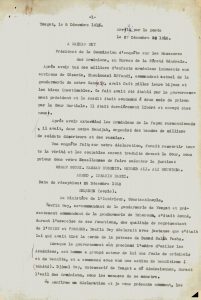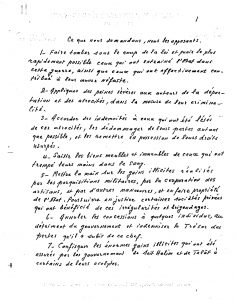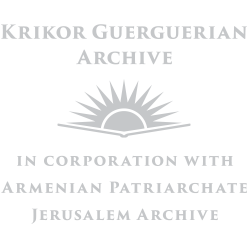 The original French documents are mainly within Archive III. While, in fact, some of these documents can be found dispersed throughout the personal archive (Archive II), we took these materials and collected them together in an organized manner for Archive III. Among these documents, not only can one find excerpts from French newspapers (such as Renaissance), but also an array of correspondences in French that were sent to diplomatic representatives or to the Patriarchate.
The original French documents are mainly within Archive III. While, in fact, some of these documents can be found dispersed throughout the personal archive (Archive II), we took these materials and collected them together in an organized manner for Archive III. Among these documents, not only can one find excerpts from French newspapers (such as Renaissance), but also an array of correspondences in French that were sent to diplomatic representatives or to the Patriarchate.
One of the most intriguing facets of the original French documents is that they contain previously unobtainable information, such as reports written habitually, between 1918-1922, that detailed the condition of the general Christians population, particularly the Armenians, in every province. These reports, which we suppose were sent to the Armenian Patriarchate by their regional delegates, pertain to the Armenians who survived the genocide and returned to their homelands. The accounts reveal how Armenians who were attempted to rebuild their lives in various regions were confronted by renewed attacks. These attacks were primarily carried out through the Turkish nationalist movement, led by Mustafa Kemal.
The reports chronicle in great detail, city-by-city – sometimes even village-by-village – the myriad attack and massacre attempts perpetrated against Armenians by nationalist forces. A crucial piece of information provided by these reports is that many of the people who had directly contributed to the annihilation of Armenians during the Genocide, and were thus at large, later took office in the nationalist movement. These people, without hesitation, walked around in villages and threatened the Armenians with renewed massacres. Moreover, these reports detail information regarding seized properties and abducted women and children.
This information, which was sent by regional Armenian representatives, was compiled by the Patriarchate and presented to the diplomatic representatives of foreign countries in the form of reports.
Another striking and noteworthy section of the French documents consists of occasionally detailed reports containing information on the perpetrators of the Genocide. These documents provide a list of the names and activities of the people responsible for deportations, massacres, property seizures and the abduction of women and children on a province and provincial district government basis. Additionally, the documents also contain detailed portraits of those who committed large-scale crimes or directly orchestrated the deportations and massacres. Along with the names of the perpetrators, these documents offer notes imparting information as to the whereabouts and activities of these people during 1918-1920, and reveal that many of them joined Mustafa Kemal’s “nationalist” movement.
